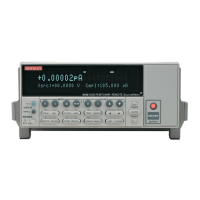13-12 Remote Operations
Angle brackets < > — Angle brackets (< >) are used to denote a parameter type. Do not in-
clude the brackets in the program message. For example:
:OUTPut <b>
The <b> indicates a Boolean-type parameter is required. Therefore, to enable
the selected source, you must send the command with the ON or 1 parameter
as follows:
:OUTPut ON
:OUTPut 1
Query commands
This type of command requests (queries) the presently programmed status. It is identified by
the question mark (?) at the end of the fundamental form of the command. Most commands
have a query form:
:ARM:TIMer? Queries the timer interval.
Most commands that require a numeric parameter (<n>) can also use the DEFault,
MINimum, and MAXimum parameters for the query form. These query forms are used to
determine the *RST default value and the upper and lower limits for the fundamental
command. Examples are:
:ARM:TIMer? DEFault Queries the *RST default value.
:ARM:TIMer? MINimum Queries the lowest allowable value.
:ARM:TIMer? MAXimum Queries the largest allowable value.
Case sensitivity
Common commands and SCPI commands are not case sensitive. You can use upper or lower
case and any case combination. Examples:
*RST = *rst
:DATA? = :data?
:SYSTem:PRESet = :system:preset
NOTE Using all upper case will result in slightly faster command response times.
Long-form and short-form versions
A SCPI command word can be sent in its long-form or short-form version. The command
subsystem tables in Section 17 provide the long-form version. However, the short-form version
is indicated by upper case characters. Examples:
:SYSTem:PRESet long-form
:SYST:PRES short-form
:SYSTem:PRES long-form and short-form combination
Note that each command word must be in long-form or short-form, and not something in
between. For example, :SYSTe:PRESe is illegal and will generate an error. The command will
not be executed.

